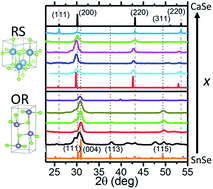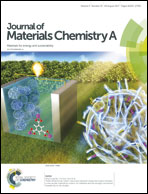Using heterostructural alloying to tune the structure and properties of the thermoelectric Sn1−xCaxSe†
Abstract
We grow and kinetically stabilize the isotropic rocksalt phase of SnSe thin films by alloying SnSe with CaSe. Thin polycrystalline films of the metastable heterostructural alloy Sn1−xCaxSe are synthesized by pulsed laser deposition on amorphous SiO2 over the entire composition range 0 < x < 1. We observe the theoretically-predicted, composition-driven change from a layered, orthorhombic structure to an isotropic, cubic structure near x = 0.18, in reasonable agreement with the theoretical value of x = 0.13 calculated from first principles. The optical band gap is highly non-linear in x and the trend agrees with theory predictions. Compared to the layered end-member SnSe, the isotropic alloy near the orthorhombic-to-rocksalt transition has a p-type electrical resistivity three orders of magnitude lower, and a thermoelectric power factor at least ten times larger. Thus manipulation of the structure of a functional material like SnSe via alloying may provide a new path to enhanced functionality, in this case, improved thermoelectric performance.



 Please wait while we load your content...
Please wait while we load your content...